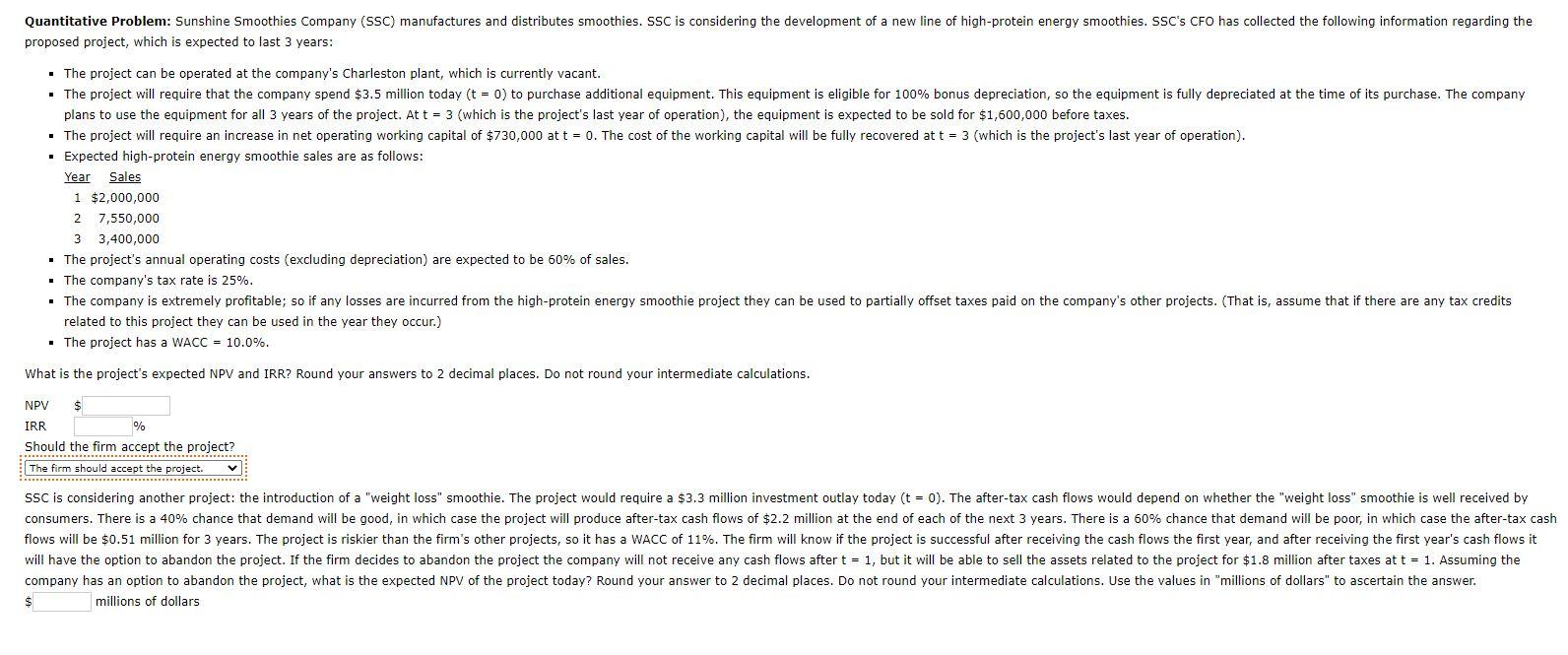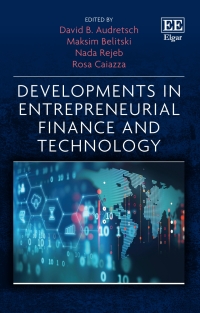
Quantitative Problem: Sunshine Smoothies Company (SSC) manufactures and distributes smoothies. SSC is considering the development of a new line of high-protein energy smoothies. SSC's CFO has collected the following information regarding the proposed project, which is expected to last 3 years: The project can be operated at the company's Charleston plant, which is currently vacant. The project will require that the company spend $3.5 million today (t = 0) to purchase additional equipment. This equipment is eligible for 100% bonus depreciation, so the equipment is fully depreciated at the time of its purchase. The company plans to use the equipment for all 3 years of the project. At t = 3 (which is the project's last year of operation), the equipment is expected to be sold for $1,600,000 before taxes. The project will require an increase in net operating working capital of $730,000 at t = 0. The cost of the working capital will be fully recovered at t = 3 (which is the project's last year of operation). Expected high-protein energy smoothie sales are as follows: Year Sales 1 $2,000,000 7,550,000 33,400,000 The project's annual operating costs (excluding depreciation) are expected to be 50% of sales. The company's tax rate is 25%. The company is extremely profitable; so if any losses are incurred from the high-protein energy smoothie project they can be used to partially offset taxes paid on the company's other projects. (That is, assume that if there are any tax credits related to this project they can be used in the year they occur.) The project has a WACC = 10.0%. 2 What is the project's expected NPV and IRR? Round your answers to 2 decimal places. Do not round your intermediate calculations. NPV IRR % Should the firm accept the project? The firm should accept the project. SSC is considering another project: the introduction of a "weight loss" smoothie. The project would require a $3.3 million investment outlay today (t = 0). The after-tax cash flows would depend on whether the "weight loss" smoothie is well received by consumers. There is a 40% chance that demand will be good, in which case the project will produce after-tax cash flows of $2.2 million at the end of each of the next 3 years. There is a 60% chance that demand will be poor, in which case the after-tax cash flows will be $0.51 million for 3 years. The project is riskier than the firm's other projects, so it has a WACC of 11%. The firm will know if the project is successful after receiving the cash flows the first year, and after receiving the first year's cash flows it will have the option to abandon the project. If the firm decides to abandon the project the company will not receive any cash flows after t = 1, but it will be able to sell the assets related to the project for $1.8 million after taxes at t = 1. Assuming the company has an option to abandon the project, what is the expected NPV of the project today? Round your answer to 2 decimal places. Do not round your intermediate calculations. Use the values in "millions of dollars" to ascertain the answer. $ millions of dollars Quantitative Problem: Sunshine Smoothies Company (SSC) manufactures and distributes smoothies. SSC is considering the development of a new line of high-protein energy smoothies. SSC's CFO has collected the following information regarding the proposed project, which is expected to last 3 years: The project can be operated at the company's Charleston plant, which is currently vacant. The project will require that the company spend $3.5 million today (t = 0) to purchase additional equipment. This equipment is eligible for 100% bonus depreciation, so the equipment is fully depreciated at the time of its purchase. The company plans to use the equipment for all 3 years of the project. At t = 3 (which is the project's last year of operation), the equipment is expected to be sold for $1,600,000 before taxes. The project will require an increase in net operating working capital of $730,000 at t = 0. The cost of the working capital will be fully recovered at t = 3 (which is the project's last year of operation). Expected high-protein energy smoothie sales are as follows: Year Sales 1 $2,000,000 7,550,000 33,400,000 The project's annual operating costs (excluding depreciation) are expected to be 50% of sales. The company's tax rate is 25%. The company is extremely profitable; so if any losses are incurred from the high-protein energy smoothie project they can be used to partially offset taxes paid on the company's other projects. (That is, assume that if there are any tax credits related to this project they can be used in the year they occur.) The project has a WACC = 10.0%. 2 What is the project's expected NPV and IRR? Round your answers to 2 decimal places. Do not round your intermediate calculations. NPV IRR % Should the firm accept the project? The firm should accept the project. SSC is considering another project: the introduction of a "weight loss" smoothie. The project would require a $3.3 million investment outlay today (t = 0). The after-tax cash flows would depend on whether the "weight loss" smoothie is well received by consumers. There is a 40% chance that demand will be good, in which case the project will produce after-tax cash flows of $2.2 million at the end of each of the next 3 years. There is a 60% chance that demand will be poor, in which case the after-tax cash flows will be $0.51 million for 3 years. The project is riskier than the firm's other projects, so it has a WACC of 11%. The firm will know if the project is successful after receiving the cash flows the first year, and after receiving the first year's cash flows it will have the option to abandon the project. If the firm decides to abandon the project the company will not receive any cash flows after t = 1, but it will be able to sell the assets related to the project for $1.8 million after taxes at t = 1. Assuming the company has an option to abandon the project, what is the expected NPV of the project today? Round your answer to 2 decimal places. Do not round your intermediate calculations. Use the values in "millions of dollars" to ascertain the answer. $ millions of dollars







